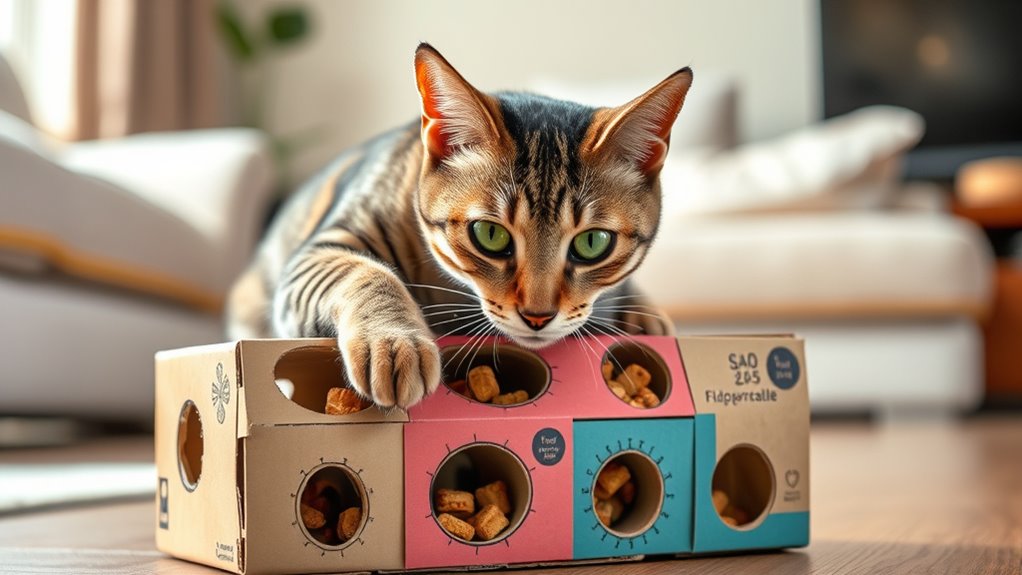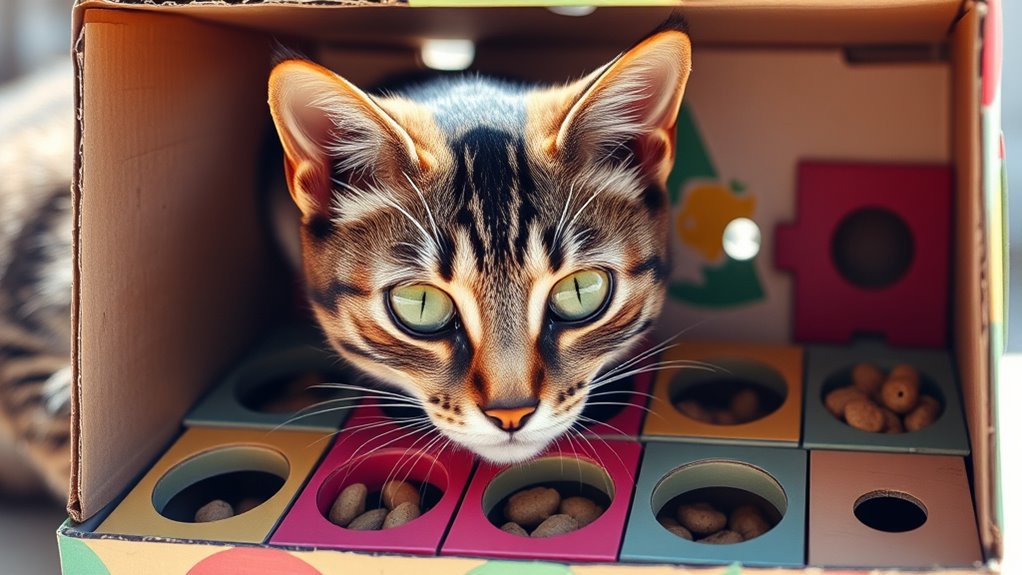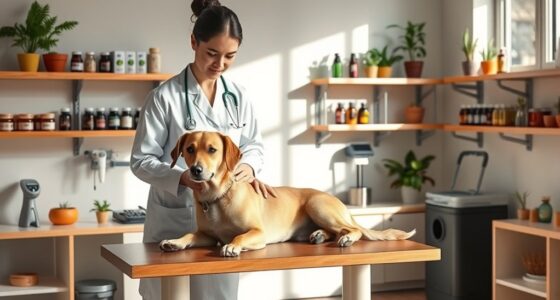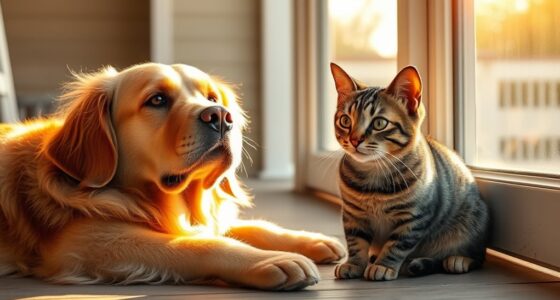To create a simple DIY puzzle feeder in just 10 minutes, start by using household items like an empty plastic bottle or a cardboard box. Cut small holes or compartments to hide treats or kibble, and add tunnels or hiding spots for your cat to explore. Cover some openings with crumpled paper or lids to encourage problem-solving. Keep experimenting with different designs—more ideas below to make playtime both fun and stimulating.
Key Takeaways
- Use household items like plastic bottles, cardboard boxes, or muffin tins to create quick, engaging puzzle feeders.
- Incorporate small compartments or holes to hide treats, encouraging problem-solving and hunting instincts.
- Add hiding spots with crumpled paper or lids to increase exploration and mental stimulation.
- Design simple tunnels or nooks for your cat to explore and access treats in under 10 minutes.
- Focus on minimal materials and quick assembly to provide effective enrichment without extensive time or tools.
Creative DIY Puzzle Feeders to Keep Cats Engaged

Cats thrive when their environment offers stimulation and variety, which is why enrichment is essential for their well-being. One of the simplest ways to achieve this is by creating DIY puzzle feeders that challenge their minds and keep them engaged. These feeders can be made in minutes and often incorporate interactive toys and hiding spots, making playtime both fun and mentally stimulating for your feline friend. When designing these feeders, consider adding small compartments or holes where treats or kibble can be hidden, encouraging your cat to use their natural hunting instincts to find them. This not only provides mental stimulation but also slows down their eating, promoting better digestion.
Interactive toys are a vital component of any DIY puzzle feeder because they invite your cat to problem-solve and stay active. You can repurpose everyday household items like plastic bottles, cardboard boxes, or toilet paper rolls into engaging toys. For example, cut small holes in a plastic bottle and fill it with treats, then let your cat figure out how to extract them. This simple activity taps into their curiosity and sharpens their problem-solving skills. Adding hiding spots within the puzzle feeder design makes the experience even more rewarding. Cats love to explore nooks and crannies, so incorporating small compartments or tunnels can make the activity more enticing. Hiding spots also mimic their natural environment, where they hunt for prey in concealed areas.
Creating your own puzzle feeder doesn’t require extensive materials or skills. You can use a cardboard box with holes cut into it, hiding treats inside. Your cat will enjoy pawing and sniffing around to uncover the goodies. Alternatively, you can use a muffin tin, placing treats in some cups and covering others with a small amount of crumpled paper or a lightweight lid to challenge your cat to uncover the reward. These setups stimulate your cat’s senses and keep their mind occupied, reducing boredom and unwanted behaviors.
Frequently Asked Questions
What Materials Are Safest for DIY Cat Puzzle Feeders?
When choosing materials for your DIY cat puzzle feeder, prioritize cat food safety by selecting non-toxic materials. Avoid plastics with BPA or phthalates, and opt for safe options like stainless steel, glass, or food-grade silicone. These materials are durable, easy to clean, and won’t harm your cat if chewed or ingested. Ensuring the materials are safe and non-toxic helps keep your feline friend healthy and happy during playtime.
How Often Should I Change My Cat’s Puzzle Feeder?
Think of your cat’s puzzle feeder as a trusted friend guiding their health journey. You should change it every 1-2 weeks to keep their curiosity alive and prevent boredom. Regularly revitalizing the feeder supports proper feeding frequency and encourages mental stimulation, which offers health benefits like improved digestion and reduced stress. By doing so, you nurture your cat’s well-being, making mealtime both fun and beneficial.
Are DIY Puzzle Feeders Suitable for All Cat Breeds?
You ask if DIY puzzle feeders suit all cat breeds. While most cats enjoy the mental stimulation, breed compatibility and activity level matter. Active breeds like Bengals thrive on such challenges, but more relaxed breeds might prefer simpler options. Consider your cat’s personality and skills when choosing or creating a puzzle feeder, ensuring it’s safe and engaging. Adjust difficulty as needed to keep your cat entertained without frustration.
Can DIY Puzzle Feeders Help Reduce Feline Boredom?
Ever wonder if DIY puzzle feeders can curb your cat’s boredom? They definitely can! By encouraging interactive play and mental stimulation, these feeders keep your feline engaged and mentally sharp. You’ll notice less destructive behavior and more happy, content moments. DIY puzzle feeders are simple, affordable, and customizable—making them a great way to provide ongoing enrichment. So, yes, they’re an effective tool to reduce boredom and boost your cat’s overall well-being.
How Do I Introduce a New Puzzle Feeder to My Cat?
When introducing a new puzzle feeder, you should start by placing it near your cat’s usual feeding spot. Use positive reinforcement, like treats or praise, to encourage curiosity. Gradually increase the time your cat spends engaging with it during play and feeding routines. This helps your cat associate the puzzle with fun and food, making it a natural part of their daily routine and enriching their environment through engaging cat play.
Conclusion
With these simple DIY puzzle feeders, you’ll see your cat’s eyes light up as they tap and paw, enthusiastic to uncover hidden treats. Imagine the joyful pounce and curious sniffing, turning every mealtime into an exciting adventure. In just ten minutes, you’ve created a world of stimulation and fun right at home. Watching your feline friend engage and thrive makes every moment worth the effort—you’re providing more than just food; you’re fueling their curiosity and happiness.









